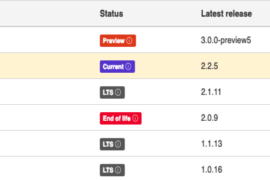

- Asp net core background task scheduler update#
- Asp net core background task scheduler code#
- Asp net core background task scheduler free#
You can also check if the user has requested cancellation with the BackgroundWorker.CancellationPending flag.
Asp net core background task scheduler code#
You put the code for your background thread into the DoWork event handler of the background worker: backgroundWorker1.DoWork += BackgroundWorker1OnDoWork Īnd within that function you are able to report progress: backgroundWorker1.ReportProgress(30, progressMessage)
Asp net core background task scheduler update#
It covers all the basics of reporting progress, cancellation, catching exceptions, and getting you back onto the UI thread so you can update the user interface. NET 2 and is designed to make it really easy for developers to run a task on a background thread.

The BackgroundWorker component was introduced in. If you’re still using it, its time to learn TPL. This technique has now really been superseded by the Task Parallel Library (see below), which does everything the ThreadPool class can do and much more. ThreadPool.QueueUserWorkItem(BackgroundTask, "ThreadPool") It’s up to you to report completion and catch exceptions. The disadvantage of this approach compared to the previous two is that it provides no mechanism for notification of when your task has finished.
Asp net core background task scheduler free#
If there are free threads it will start immediately, otherwise it will be queued up. You just call QueueUserWorkItem and pass in your method and state. NET (v1.1 I think) and provided an extremely simple way to request that your method be run on a thread from the thread pool. The ThreadPool was introduced fairly early on in. I only tend to use this approach if I need a dedicated thread for a single task that is running for the lifetime of my application. NET manage the creation of threads rather than spinning them up yourself. This may seem like the obvious choice if you need to run something on another thread, but it is actually overkill for most scenarios. You can create a new Thread object, set up various properties such as the method to execute, thread name, and priority, and then start the thread. NET since the beginning is the Thread class. Thread ClassĪnother option that has been in. It is quite powerful, but is a fairly cumbersome programming model, and not particularly great if you want to chain asynchronous methods together as you end up with convoluted flow control over lots of callbacks, and find yourself needing to pass state around in awkward ways. This model is called the Asynchronous Programming Model (APM). BeginInvoke also returns an IAsyncResult allowing us to check or wait for completion. We call EndInvoke to get any return value and also to catch any exception thrown in our function. This allows us to get notification when the background task has completed. The BeginInvoke method also takes a callback parameter and some optional state. Here we’ll call a method that takes a string: Action d = BackgroundTask ĭ.BeginInvoke("BeginInvoke", null, null) If you don’t care about when it ends, it’s actually quite simple to do. NET you have been able to take any delegate and call BeginInvoke on it to run that method asynchronously. We’ll start with the ones that have been around the longest, and move on to the newer options. So here’s my very quick guide to the choices available. It can be rather bewildering to decide which one you ought to use. Over the years, Microsoft have provided us with multiple different ways to kick off tasks on a background thread in.


 0 kommentar(er)
0 kommentar(er)
